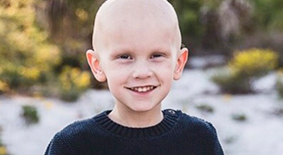In the Midst of a 4-Year Leukemia Battle, Eric Finds Joy in Everyday Things
Eric has had many mountains to climb over the course of a lengthy treatment regimen, but he remains committed to embracing normalcy and appreciating every opportunity he’s given.

It’s hard to have a “normal” life when you’re a teenage boy facing a lengthy cancer journey; but 16-year-old Eric is doing his best to make the most of his high school years despite multiple hospitalizations and treatments.
“No matter what happens next, I tell myself that eventually it’s going to get better,” Eric says. “I just have to keep my faith in God.”
Supportive from the start
Eric’s cancer journey began in 2017 when he started complaining of back pain. His mother, Kim Lenning, says he was in the middle of ninth-grade baseball conditioning, so they thought he was just sore from workouts. However, the pain started to get worse in December.
Eric saw their family doctor, who found that he had two compressed vertebrae and so referred him to an orthopedist. When the orthopedist discovered five compressed vertebrae, Eric was ordered to go see a hematologist.
Eric had bloodwork done on a Friday. Over the weekend, however, he continued to get worse. By the time Kim got home from work on Monday, her son was pale and could barely walk. They immediately drove to the Emergency Department at Children’s Healthcare of Atlanta Scottish Rite Hospital, where Eric underwent additional testing.
At about 2 a.m. the next day, an oncologist shared the news with Eric’s family that he had leukemia. He was immediately admitted into the Aflac Cancer and Blood Disorders Center of Children’s and began what would be a nearly four-year chemotherapy treatment protocol.
Staying the course
In the last year and a half, Eric has had many mountains to climb, Kim says, including spending Christmas at the hospital after he was diagnosed, extended hospital stays and missing school, but he continues to do well in school and stay in the top of his class.
“There were days I wanted to go into my bathroom and just bawl my eyes out, but I’d see Eric just smiling, and I would ask myself, Who am I to go and cry when he’s sitting here smiling and doing a science research paper? I’ve got to toughen up,” Kim says. “Eric seemed like the strongest one of all of us, believe it or not.”
He’s now in the maintenance phase of his treatment, only going to the center once a month for treatments and having spinals every two months, through which doctors inject chemo directly into Eric’s spinal fluid. He is also taking oral chemo each night at home.
The family is so thankful for the support and unconditional love the team has shared in the Aflac Cancer and Blood Disorders Center. “They were amazing from the very first moment we walked in,” Kim says. “We just wanted to make the best of it, and the staff and volunteers there helped us do just that.”
Opportunities of a lifetime
Eric has been given some unique opportunities as a representative of the Aflac Cancer and Blood Disorders Center. One of these was meeting Atlanta Falcons quarterback Matt Ryan and speaking at a special fundraising dinner Matt hosts annually.
“It’s one of the hardest things to hear that you have cancer, but being able to go to events like that really does help you feel like you’re living a normal life,” Eric admits. “Because just sitting at home or in the hospital sick is no fun.”
This collaboration between Children’s and the Falcons is just one of many ways the community continues to show children and families in the Aflac Cancer and Blood Disorders Center that someone is out there cheering them on each and every day.
“Children’s has been magnificent,” Eric adds. “It’s hard to even describe. From the time I was diagnosed, they were there for me and my family.”

One of the largest centers for pediatric cancer in the U.S.
No parent wants to hear the word “cancer"—but with our team by their side, patients and families can rest assured that they are receiving the full spectrum of advanced therapies available to treat these complex diseases.
See HowStories of Our Cancer Warriors
Contact Us 404-785-1112


